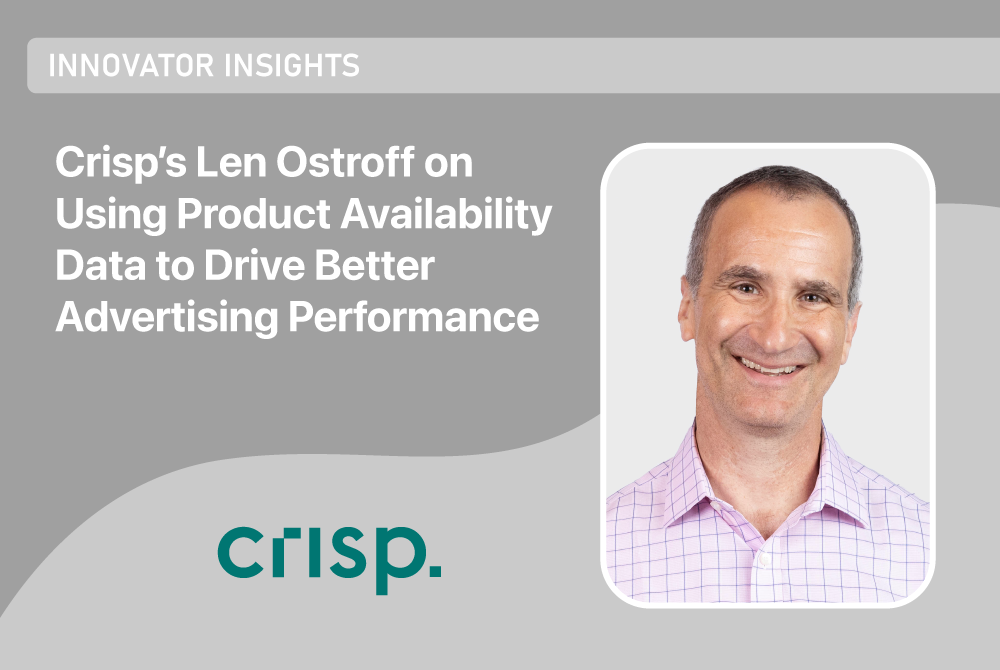There are many different ways you could describe Crisp – a provider of retail data for the CPG industry, an open data collaboration platform to enable real-time sales and inventory analysis– but Len Ostroff can boil it down to two simple words.
“We are ‘strictly pipes’,” the company’s senior vice-president of sales and partnerships explains. “We’re not a solutions company. We’re not a media company. We act as an agent on behalf of the supplier, extracting thousands of points of data out of retailer data portals, harmonizing the data across retailers, and then exporting it to whatever line of business application or cloud provider the supplier wants – be that Excel or PowerBI, or Google Cloud or Snowflake. The data is stored in the supplier’s own secure data warehouse. Crisp provides acceleration and automation solutions that enable the supplier to get the data that they already license from the retailer in the form and manner in which they want it.”
If you don’t immediately grasp why that matters, Ostroff suggests thinking of a well constructed advertising campaign. The brand has worked with their agency on the creative elements, the campaign has launched and the ad is seen by potential customers. So far everything has gone perfectly. But…imagine if a potential customer goes to a store to buy your product only to discover that it is out of stock. Not only is the customer disappointed and a sale is lost, but the customer may buy a product from your competitor instead. With today’s supply chain issues, out of stocks happen more than you might think – up to 15% of products are out of stock at any given time, according to the Consumer Brands Association. We all remember the toilet paper shortage of 2020! Having ‘shelf aware’ advertising campaigns eliminates this situation.
As marketers try to make the most of the shopping behavior that happens during the holiday season and beyond, managing marketing resources effectively is paramount, Ostroff said.
“The first thing that happens in a macroeconomic downturn is that marketing budgets get cut,” Ostroff told Brand Innovators. “But if you have direct visibility into what products are selling on the shelf, and you know how fast those products are selling, wouldn’t you use that opportunity to double down on advertising and try to grow your shelf share? Don’t cut your advertising, use it more effectively and strategically. It just makes sense.”
Crisp didn’t set out to change retail media spending. The company’s original mission was – and remains – to combat food waste by bringing greater transparency and data sharing between retailers, distributors, and their suppliers. As the firm’s technology has evolved, however, it began connecting to the marketing community ecosystem as a strategic partner. After all, advertising is used to sell more products, and if the supplier knows it has products that are about to expire, or has too much inventory, it can use advertising and promotions to move them more quickly before they spoil or go to waste.
Last month, for instance, Crisp announced an integration with The Trade Desk to bring advertisers real-time inventory data from all major retailers and distributors including Target, Amazon, UNFI and CVS. This means marketers can target ad spending based on actual product availability and optimize campaign performance nightly. No more 6-week delayed modeled data to inform ad campaigns, Crisp data is direct from the store and SKU level. Ostroff also said this includes more than two years of historical data that helps both campaign planning and measurement.
Although some of this retail data was provided to sales teams in the past, Ostroff explained that it was clunky and non-normalized and often didn’t make its way to marketing departments, partly because retailer portals run the gamut from sophisticated API-based platforms to basic auto-generated email reports. This left brands paying significant dollars for legacy solutions and delayed, panel-based data.
“With panel data, it’s only as good as the retailers in the panel and then it’s also modeled. At best, it’s directionally accurate, but it’s impossible to make real-time decisions off of delayed data. Additionally, you can’t capture your entire retail footprint as the panels only cover certain retailers. With Crisp, the supplier gets real-time sales and inventory data directly from retailer portals, normalized across their entire retailer footprint. This provides that ‘single source of truth’ that the entire organization can rely on.”
Recognize availability as a foundation for personalization
Lots of brands and their partners see personalization – where they target consumers based on known preferences – as key to driving loyalty and an increased share of wallet. However there’s little value in being so precise when the brand in question can’t supply the product being offered.
Ostroff said marketers should couple their personalization strategies with data that identifies which products are achieving significant sales velocity and use it to make the business case for more relevant advertising.
“What the CFO wants to hear is, ‘Hey, we’re not going to back down. We’re actually going to push more products through and take share during a downturn because we have visibility into the data that drives our decisions,’” he said.
‘Just-in-time’ advertising could drive bigger bottom-line results
Some retailers may currently be sitting on excess inventory from Thanksgiving. The same might happen once Christmas comes and goes. Ostroff said retailers could begin using data to not only plan campaigns but react to consumer behavior. A good example might be increasing the advertising to support a local store that needs to drive more sales around a particular product before a holiday peak period ends. No retailer wants to be stuck with seasonal goods that are out of season.
Another emerging use case is what Ostroff called “shelf defense,” when a brand is trying to bring a product to market for the first time.
“If I’ve got a new product that’s launching, I only have 60 days to prove to a retailer that I deserve to be on their shelf – and once I get that shelf space, I don’t want to give it up,” he said. “So I should definitely load up on the advertising in that particular market or across those particular retailers to defend the space that I fought so hard to acquire.”
Strive to measure what was once considered intangible
“It used to be the easiest money in advertising – it was just ‘give me the reach,’” Ostroff said, referring to brand campaigns. As shelf availability data becomes more commonplace, however, Ostroff suggested marketers could do more controlled experiments that make it possible to associate objective metrics with branding activities. Crisp’s recent integration with Teads aims to make what were traditionally branding campaigns into more shoppable video ads layered with product availability data.
“With Crisp,” Ostroff explains, “you can objectively understand whether those campaigns actually drove sales or increased share.”




